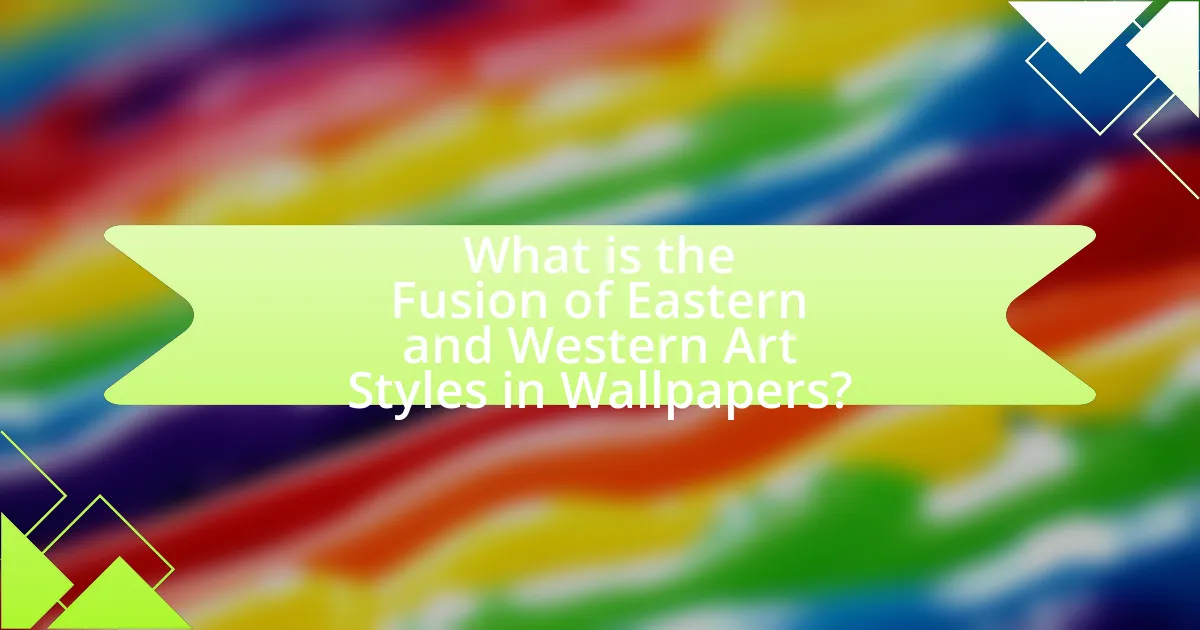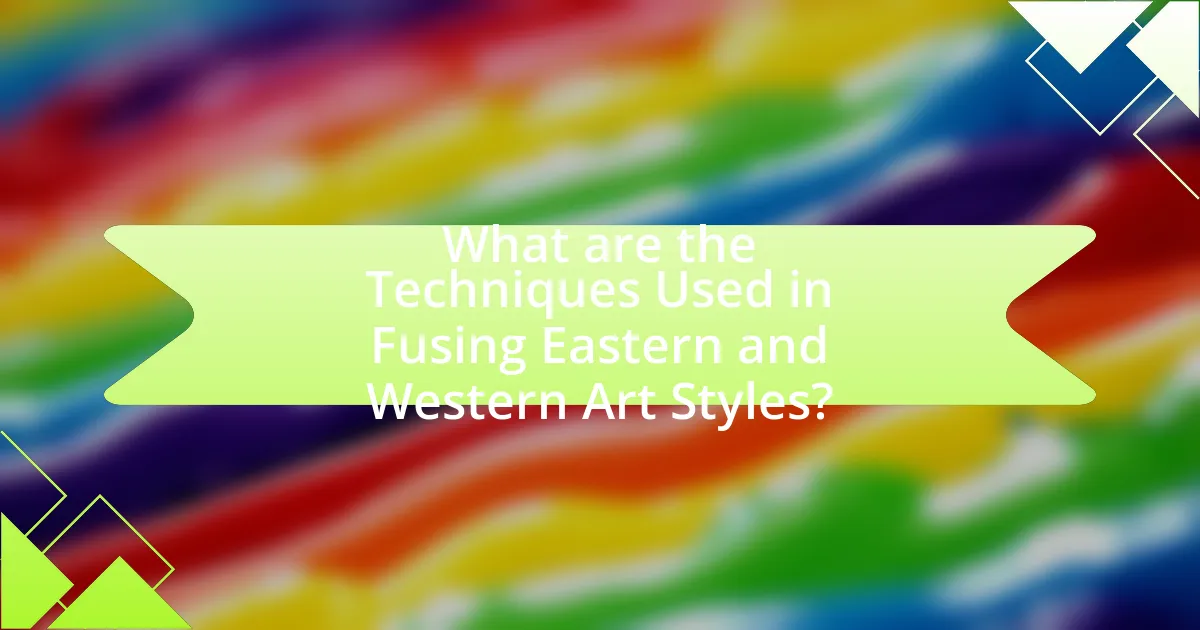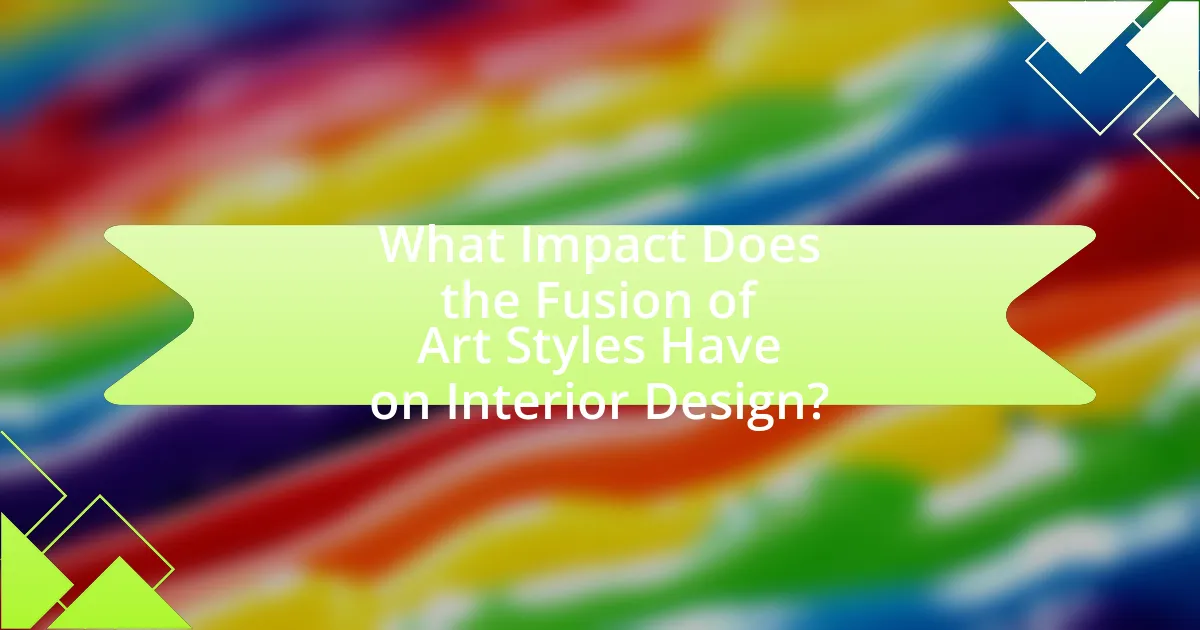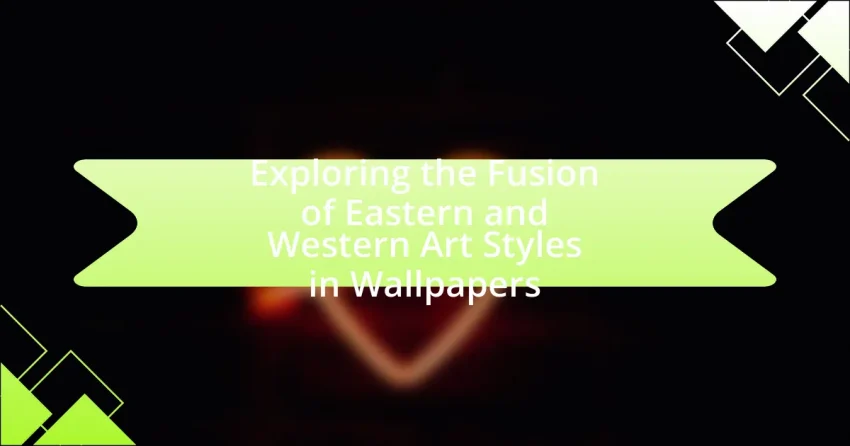The article explores the fusion of Eastern and Western art styles in wallpaper design, highlighting how traditional motifs and techniques from both cultures create visually appealing and culturally rich designs. It examines the differences in aesthetic principles and thematic elements between Eastern and Western styles, detailing key characteristics and techniques used in each. The significance of this fusion in contemporary design is discussed, emphasizing its role in enhancing creativity, reflecting globalization, and influencing interior design trends. Additionally, the article addresses practical considerations for selecting fusion wallpapers and offers insights for designers on effectively incorporating these styles into their projects.

What is the Fusion of Eastern and Western Art Styles in Wallpapers?
The fusion of Eastern and Western art styles in wallpapers combines traditional motifs and techniques from both cultures to create visually striking designs. This artistic blend often features Eastern elements such as intricate patterns, calligraphy, and natural themes alongside Western influences like perspective, realism, and bold color palettes. For instance, wallpapers may showcase Asian landscapes or floral designs integrated with Western artistic styles, resulting in a harmonious aesthetic that appeals to diverse tastes. This fusion reflects a growing trend in global art, where cultural exchange enhances creativity and innovation in design.
How do Eastern and Western art styles differ in their approach to wallpaper design?
Eastern and Western art styles differ significantly in their approach to wallpaper design, primarily in their aesthetic principles and thematic elements. Eastern wallpaper design often emphasizes intricate patterns, natural motifs, and a sense of harmony with nature, reflecting cultural values such as balance and tranquility. For example, traditional Chinese wallpapers frequently feature landscapes, flora, and fauna, utilizing a limited color palette to create a serene atmosphere. In contrast, Western wallpaper design tends to focus on bold colors, geometric patterns, and historical or narrative themes, often drawing inspiration from various artistic movements such as Baroque or Art Deco. This divergence is evident in the use of vibrant colors and elaborate designs in Western wallpapers, which aim to make a statement or convey a specific mood. The differences in these approaches highlight the cultural contexts that shape wallpaper design in Eastern and Western art.
What are the key characteristics of Eastern art styles in wallpapers?
Eastern art styles in wallpapers are characterized by intricate patterns, vibrant colors, and a strong emphasis on nature and symbolism. These styles often feature motifs such as floral designs, landscapes, and animals, reflecting the cultural significance of nature in Eastern philosophies. Additionally, the use of calligraphy and geometric patterns is prevalent, showcasing the artistic traditions of various Eastern cultures, including Chinese, Japanese, and Indian art. Historical context reveals that these elements are rooted in centuries-old practices, where art served both decorative and spiritual purposes, thus reinforcing the connection between aesthetics and cultural identity.
What are the defining features of Western art styles in wallpapers?
The defining features of Western art styles in wallpapers include a focus on realism, intricate patterns, and the use of perspective. Western wallpapers often showcase detailed landscapes, historical scenes, and floral motifs, reflecting the artistic movements such as Baroque, Rococo, and Art Nouveau. For instance, the Baroque style emphasizes dramatic contrasts and ornate designs, while Art Nouveau incorporates flowing lines and organic forms. These styles are characterized by their emphasis on craftsmanship and the use of high-quality materials, which can be traced back to the Renaissance period when wallpaper began to gain popularity in Europe.
Why is the fusion of these art styles significant in contemporary wallpaper design?
The fusion of Eastern and Western art styles is significant in contemporary wallpaper design because it creates a unique aesthetic that reflects globalization and cultural exchange. This blending allows designers to incorporate diverse motifs, techniques, and philosophies, resulting in wallpapers that appeal to a broader audience. For instance, the integration of traditional Eastern patterns with modern Western design principles can enhance visual interest and create a dialogue between different cultural narratives. This significance is further supported by market trends indicating a growing consumer preference for eclectic and culturally rich designs, as evidenced by a 2021 report from the Interior Design Association, which highlighted a 30% increase in demand for wallpapers that showcase cross-cultural influences.
How does cultural exchange influence wallpaper design trends?
Cultural exchange significantly influences wallpaper design trends by blending artistic elements from diverse cultures, resulting in innovative patterns and styles. For instance, the incorporation of Eastern motifs, such as intricate floral designs and calligraphy, into Western wallpaper designs has created a unique aesthetic that appeals to a global audience. Historical examples include the popularity of Chinoiserie in 18th-century Europe, where Chinese artistic influences transformed European interior design. This fusion not only reflects the interconnectedness of cultures but also drives market demand for wallpapers that celebrate this diversity, as seen in contemporary collections that feature cross-cultural themes.
What role does globalization play in the fusion of art styles?
Globalization significantly facilitates the fusion of art styles by enabling cross-cultural exchanges and collaborations. This interconnectedness allows artists from diverse backgrounds to share techniques, themes, and inspirations, leading to innovative blends of Eastern and Western art styles. For instance, the rise of digital platforms has made it easier for artists to access and incorporate elements from various cultures, resulting in unique artistic expressions that reflect a globalized perspective. The prevalence of international art exhibitions and cultural festivals further exemplifies this trend, showcasing works that merge different artistic traditions and styles, thereby enriching the global art landscape.

What are the Techniques Used in Fusing Eastern and Western Art Styles?
Techniques used in fusing Eastern and Western art styles include the integration of color palettes, blending of motifs, and the application of mixed media. Artists often utilize vibrant colors characteristic of Eastern art alongside the more subdued tones found in Western styles to create a harmonious visual experience. Additionally, motifs such as traditional Eastern patterns are combined with Western artistic elements, allowing for a dialogue between the two cultures. The use of mixed media, incorporating materials and techniques from both traditions, further enhances this fusion, as seen in contemporary artworks that draw inspiration from both Eastern calligraphy and Western abstract forms. This approach not only reflects a cross-cultural exchange but also enriches the artistic narrative, making it relevant in today’s globalized art scene.
How are traditional techniques adapted in modern wallpaper design?
Traditional techniques are adapted in modern wallpaper design through the integration of hand-painted motifs and block printing methods, which are combined with contemporary materials and digital printing technologies. This fusion allows designers to maintain the aesthetic qualities of traditional art while enhancing durability and ease of application. For example, the use of digital printing enables the reproduction of intricate patterns that were historically created by hand, thus preserving cultural heritage while catering to modern consumer preferences for customization and sustainability.
What traditional Eastern techniques are commonly used in wallpapers?
Traditional Eastern techniques commonly used in wallpapers include block printing, hand-painted designs, and silk-screen printing. Block printing, originating from China, involves carving intricate patterns into wood blocks, which are then inked and pressed onto paper or fabric, creating detailed and repetitive designs. Hand-painted designs, prevalent in Japanese and Chinese art, showcase unique artistry and craftsmanship, often depicting nature, landscapes, or cultural motifs. Silk-screen printing, also utilized in Eastern art, allows for vibrant colors and complex patterns to be applied to wallpaper, enhancing visual appeal. These techniques reflect the rich cultural heritage and artistic traditions of Eastern societies, contributing to the aesthetic diversity in wallpaper design.
Which Western techniques complement Eastern styles in wallpaper design?
Western techniques that complement Eastern styles in wallpaper design include the use of digital printing, layering, and mixed media applications. Digital printing allows for intricate designs and vibrant colors that enhance traditional Eastern motifs, such as floral patterns or calligraphy. Layering techniques can create depth and texture, which harmonizes with the flat, often minimalist aesthetics found in Eastern designs. Mixed media applications, incorporating materials like fabric or metallic finishes, further enrich the visual experience, bridging the gap between the ornate details of Eastern art and the clean lines typical of Western styles. These techniques foster a dialogue between the two artistic traditions, resulting in innovative and visually striking wallpaper designs.
What innovative methods are emerging in the fusion of these styles?
Innovative methods emerging in the fusion of Eastern and Western art styles in wallpapers include digital printing techniques that allow for intricate designs and the blending of cultural motifs. These methods utilize advanced technology, such as high-resolution printing and software that enables artists to seamlessly integrate traditional Eastern patterns with contemporary Western aesthetics. For instance, the use of augmented reality in wallpaper design allows consumers to visualize how these fusions will look in their spaces, enhancing the interactive experience. Additionally, collaborations between artists from both cultures are leading to unique collections that reflect a harmonious blend of styles, showcasing the versatility and adaptability of wallpaper as a medium for artistic expression.
How does technology influence the creation of fusion wallpapers?
Technology significantly influences the creation of fusion wallpapers by enabling advanced design tools and techniques that blend Eastern and Western art styles. Digital software allows artists to manipulate images, colors, and patterns with precision, facilitating the seamless integration of diverse cultural elements. For instance, graphic design programs like Adobe Photoshop and Illustrator provide features such as layering, filters, and vector graphics, which enhance the creative process. Additionally, the rise of 3D printing technology allows for the production of textured wallpapers that incorporate traditional motifs in innovative ways, thus expanding the possibilities for artistic expression. This technological advancement not only streamlines the design process but also democratizes access to high-quality wallpaper production, allowing a broader range of artists to participate in the fusion of styles.
What are some examples of successful fusion wallpaper designs?
Successful fusion wallpaper designs include the “Chinoiserie” style, which blends Chinese artistic elements with European motifs, and the “Japanese Minimalism” design that incorporates traditional Japanese patterns with modern Western aesthetics. For instance, the “Lotus Blossom” wallpaper combines intricate Asian floral designs with a contemporary color palette, appealing to both Eastern and Western sensibilities. Additionally, the “Geometric Zen” wallpaper merges Japanese Zen garden patterns with Western geometric shapes, creating a harmonious balance that resonates with diverse audiences. These designs exemplify the successful integration of cultural elements, enhancing interior spaces while reflecting a global artistic dialogue.

What Impact Does the Fusion of Art Styles Have on Interior Design?
The fusion of art styles significantly enhances interior design by creating unique, visually stimulating environments that reflect diverse cultural influences. This blending allows designers to incorporate elements from both Eastern and Western art, resulting in spaces that are not only aesthetically pleasing but also rich in narrative and meaning. For instance, the combination of traditional Eastern motifs with modern Western aesthetics can lead to innovative wallpaper designs that serve as focal points in a room, thereby influencing the overall ambiance and emotional response of the occupants. Studies have shown that such eclectic designs can increase the perceived value of a space, as they resonate with a broader audience and cater to varied tastes, ultimately enriching the interior experience.
How does the choice of wallpaper affect the overall aesthetic of a space?
The choice of wallpaper significantly influences the overall aesthetic of a space by establishing mood, style, and visual interest. Different patterns, colors, and textures can evoke various emotions and perceptions; for instance, bold geometric designs may create a modern feel, while floral patterns can impart a sense of warmth and comfort. Research indicates that color psychology plays a crucial role in how individuals perceive their environment, with specific hues affecting feelings of calmness or energy. Additionally, the integration of Eastern and Western art styles in wallpaper design can enhance cultural richness and depth, allowing for a unique blend that reflects personal taste and enhances the character of the space.
What emotions or themes can fusion wallpapers evoke in interior spaces?
Fusion wallpapers can evoke a range of emotions and themes in interior spaces, including harmony, cultural appreciation, and creativity. These wallpapers blend elements from both Eastern and Western art styles, creating a visual dialogue that fosters a sense of balance and unity. For instance, the incorporation of traditional motifs from Eastern cultures alongside contemporary Western designs can inspire feelings of nostalgia and curiosity, encouraging viewers to explore diverse cultural narratives. Additionally, the vibrant colors and intricate patterns often found in fusion wallpapers can stimulate creativity and energize a space, making it feel more dynamic and inviting.
How do fusion wallpapers enhance cultural storytelling in design?
Fusion wallpapers enhance cultural storytelling in design by integrating elements from both Eastern and Western art styles, creating a visual narrative that reflects diverse cultural influences. This integration allows for a richer representation of cultural themes, as seen in designs that combine traditional motifs from Asian art with contemporary Western aesthetics. For example, the use of intricate patterns and symbolism from Eastern cultures alongside modern color palettes and materials can evoke a sense of history while appealing to contemporary tastes. This blending not only preserves cultural heritage but also fosters cross-cultural dialogue, making the design more relatable and engaging for a global audience.
What are the practical considerations when selecting fusion wallpapers?
When selecting fusion wallpapers, practical considerations include the compatibility of design elements, material durability, and maintenance requirements. Compatibility ensures that the fusion of Eastern and Western art styles harmonizes with existing decor, enhancing the overall aesthetic. Material durability is crucial, as wallpapers made from high-quality materials like vinyl or non-woven fabric resist wear and tear, ensuring longevity. Maintenance requirements also play a significant role; wallpapers that are washable or easy to clean are preferable for high-traffic areas. These considerations collectively ensure that the chosen wallpaper not only complements the space but also stands the test of time.
What tips should consumers consider when choosing fusion wallpaper for their homes?
Consumers should consider the harmony of design elements when choosing fusion wallpaper for their homes. Selecting wallpaper that blends Eastern and Western art styles requires attention to color schemes, patterns, and textures that complement existing decor. For instance, a balance between intricate Eastern motifs and minimalist Western designs can create a cohesive look. Additionally, consumers should evaluate the material and durability of the wallpaper, as high-quality options can enhance the aesthetic while ensuring longevity. Research indicates that well-chosen wallpaper can significantly impact the ambiance of a space, making it essential to consider personal style and the overall theme of the room.
How can designers effectively incorporate fusion wallpapers into their projects?
Designers can effectively incorporate fusion wallpapers into their projects by blending elements from both Eastern and Western art styles to create visually striking and culturally rich designs. This approach allows designers to leverage the intricate patterns and motifs characteristic of Eastern art alongside the bold colors and forms typical of Western styles, resulting in a harmonious aesthetic that appeals to diverse audiences. For instance, using traditional Japanese floral patterns in combination with modern geometric shapes can create a unique wallpaper that resonates with contemporary design trends while honoring cultural heritage. This method not only enhances the visual appeal of a space but also fosters a deeper appreciation for the artistic traditions of both cultures.
